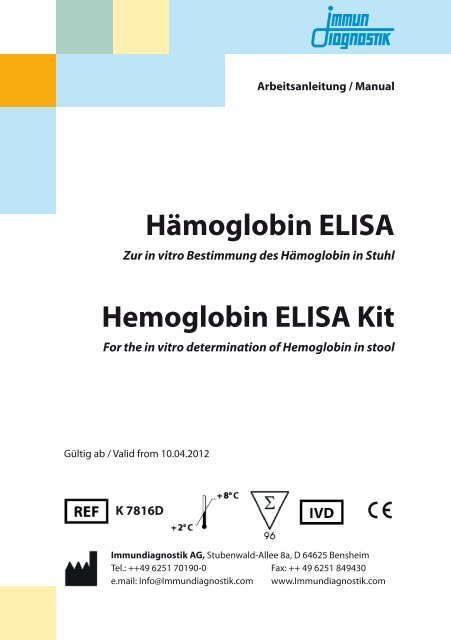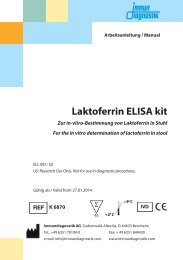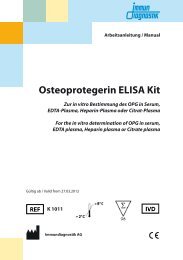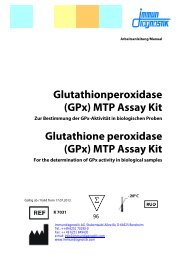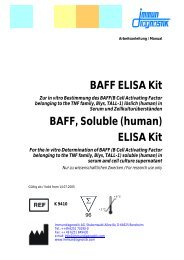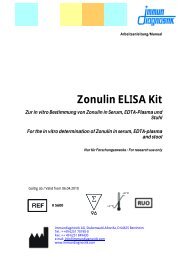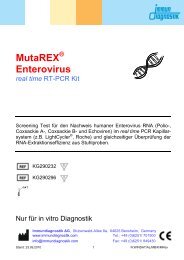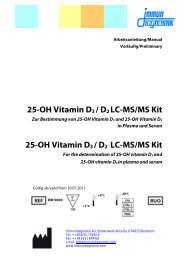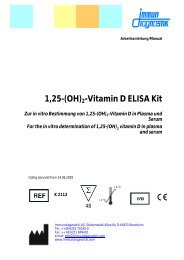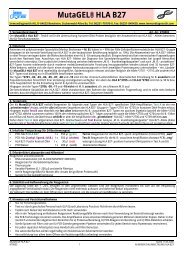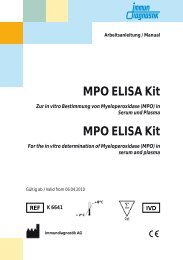Hemoglobin ELISA Kit - bei Immundiagnostik
Hemoglobin ELISA Kit - bei Immundiagnostik
Hemoglobin ELISA Kit - bei Immundiagnostik
Create successful ePaper yourself
Turn your PDF publications into a flip-book with our unique Google optimized e-Paper software.
Ar<strong>bei</strong>tsanleitung / Manual<br />
Hämoglobin <strong>ELISA</strong><br />
Zur in vitro Bestimmung des Hämoglobin in Stuhl<br />
<strong>Hemoglobin</strong> <strong>ELISA</strong> <strong>Kit</strong><br />
For the in vitro determination of <strong>Hemoglobin</strong> in stool<br />
Gültig ab / Valid from 10.04.2012<br />
K 7816D<br />
<strong>Immundiagnostik</strong> AG, Stubenwald-Allee 8a, D 64625 Bensheim<br />
Tel.: ++49 6251 70190-0 Fax: ++ 49 6251 849430<br />
e.mail: Info@<strong>Immundiagnostik</strong>.com www.<strong>Immundiagnostik</strong>.com
Ar<strong>bei</strong>tsanleitung / Manual human <strong>Hemoglobin</strong><br />
Inhalt<br />
Content ________________________________________________________14<br />
1. VERWENDUNGSZWECK _______________________________________2<br />
2. EINLEITUNG _________________________________________________2<br />
3. TESTPRINZIP ________________________________________________2<br />
4. INHALT DER TESTPACKUNG ___________________________________3<br />
5. ERFORDERLICHE LABORGERÄTE UND HILFSMITTEL _______________3<br />
7. HINWEISE UND VORSICHTSMASSNAHMEN ______________________5<br />
8. PROBENVORBEREITUNG ______________________________________5<br />
Stuhlprobenextraktion_________________________________________________ 5<br />
9. TESTDURCHFÜRHUNG ________________________________________6<br />
Hinweise____________________________________________________________ 6<br />
Pipettierschema_ _____________________________________________________ 7<br />
10. ERGEBNISSE ________________________________________________8<br />
11. EINSCHRÄNKUNGEN _________________________________________8<br />
12. QUALITÄTSKONTROLLE _______________________________________8<br />
Erwartete_Ergebnisse_ _________________________________________________ 8<br />
13. TESTCHARAKTERISTIKA ______________________________________9<br />
Präzision_und_Reproduzierbarkeit_________________________________________ 9<br />
Sensitivität_und_Spezifität_______________________________________________ 9<br />
14. LITERATUR ________________________________________________ 10<br />
15. ALLGEMEINE HINWEISE ZUM TEST ___________________________ 11<br />
1
Ar<strong>bei</strong>tsanleitung / Manual human <strong>Hemoglobin</strong><br />
1. VERWENDUNGSZWECK<br />
Der hier beschriebene Assay ist für die Bestimmung von Hämoglobin in Stuhl geeignet. Nur<br />
zur in-vitro-Diagnostik.<br />
2. EINLEITUNG<br />
Hämoglobin kann als Marker für gastrointestinale Blutungen verwendet werden. Die Untersuchung<br />
okkulten Blutes wird in den meisten Fällen zur Erkennung kolorektaler Karzinome<br />
durchgeführt.<br />
Im Gegensatz zu handelsüblichen Hämoglobin Schnelltests, kann <strong>bei</strong> dem Hämoglobin <strong>ELISA</strong><br />
auf eine vorgeschaltete Diäteinhaltung (kein rohes Fleisch etc.) verzichtet werden. Durch die<br />
Antikörperwahl werden falsch-positive Ergebnisse nahezu ausgeschlossen.<br />
Der immunologische Test erkennt humanes Hämoglobin in 100-fach niedrigerer Konzentration.<br />
Dadurch werden falsch-negative Ergebnisse vermieden.<br />
Indikationen:<br />
� Okkultes Blut im Stuhl<br />
� Morbus Crohn, Colitis Ulcerosa<br />
� Verdacht auf Kolon Karzinom<br />
� Polypen im Kolo-Rektum<br />
3. TESTPRINZIP<br />
Der vorliegende Enzyme-Linked-Immuno-Sorbent-Assay (<strong>ELISA</strong>) dient zur quantitativen Erfassung<br />
des humanen Hämoglobins im Stuhl. Proben und Standards werden in die mit anti-<br />
Hämoglobin Antikörpern beschichteten Vertiefungen der Mikrotiterwells gegeben. Nach einer<br />
Inkubation werden nicht-gebundene Komponenten durch einen Waschschritt entfernt.<br />
Das gebundene Antigen wird mittels eines Antikörper-POD/TMB-Systems nachgewiesen. Die<br />
Quantifizierung erfolgt durch Bestimmung der Extinktion <strong>bei</strong> 450 nm. Anhand eines mitgeführten<br />
Kalibrators und dessen Bezug zu einer Mastereichkurve lässt sich die Konzentration<br />
des Hämoglobins der Proben ermitteln.<br />
2
Ar<strong>bei</strong>tsanleitung / Manual human <strong>Hemoglobin</strong><br />
4. INHALT DER TESTPACKUNG<br />
Artikel Nr. Abkürzung <strong>Kit</strong> Komponenten Menge<br />
K 7816D MTP PLATE Mikrotiterplatte, vorbeschichtet 96<br />
K 7816D WP WASHBUF <strong>ELISA</strong> Waschpufferkonzentrat 10x 2 x 100 ml<br />
K 7816D EP EXBUF Extraktionspufferkonzentrat 2.5 x 1 x 100 ml<br />
K 7816D PV SAMPLEBUF Probenverdünnungspuffer,<br />
gebrauchsfertig<br />
K 7816D K CONJ Konjugat, (Maus anti human Hb,<br />
Peroxidase-markiert), gebrauchsfertig<br />
K 7816D ST STD Standards, lyophilisiert<br />
(50; 10; 3.3; 0.67; 0 µg/g)<br />
1 x 100 ml<br />
1 x 15 ml<br />
4 x 5 vials<br />
K 7816D KO CTRL Kontrollen, lyophilisiert 4 x 2 vials<br />
K 7816D TMB SUB TMB Substrat (Tetramethyl-<br />
benzidin), gebrauchsfertig<br />
K 7816D AC STOP <strong>ELISA</strong> Stopplösung,<br />
gebrauchsfertig<br />
5. ERFORDERLICHE LABORGERÄTE UND HILFSMITTEL<br />
1 x 15 ml<br />
1 x 15 ml<br />
� Reinstwasser*<br />
� Laborwaage<br />
� Präzisionspipetten und Einmalpipettenspitzen mit variablen Volumina von 10-1000 µl<br />
� Folie zum Abkleben der Mikrotiterplatte<br />
� Mikrotiterplattenschüttler<br />
� Multikanal- bzw. Multipipette<br />
� Zentrifuge, 3000 x g<br />
� Vortex-Mixer<br />
� Laborübliche Glas- oder Plastikröhrchen (Einmalartikel)<br />
� Mikrotiterplattenphotometer mit Filter 450 nm (Referenzfilter 620 oder 690 nm)<br />
* <strong>Immundiagnostik</strong> AG empfiehlt die Verwendung von Reinstwasser nach ISO 3696. Es<br />
handelt sich da<strong>bei</strong> um Wasser des Typs 1, welches frei von ungelösten und kolloidalen<br />
Ionen und organischen Molekülen ist (frei von Partikeln > 0,2 µm) mit einer elektrischen<br />
Leitfähigkeit von 0,055 µS/cm <strong>bei</strong> 25°C (≤18,2 MΩ cm).<br />
3
Ar<strong>bei</strong>tsanleitung / Manual human <strong>Hemoglobin</strong><br />
4<br />
6. VORBEREITUNG UND LAGERUNG DER REAGENZIEN<br />
• Bitte achten Sie <strong>bei</strong> mehrfachem Einsatz der Platte darauf, dass die Reagenzien,<br />
wie in der Vorschrift beschrieben, gelagert und nur die für den jeweiligen Ansatz<br />
benötigten Reagenzienmengen frisch angesetzt werden. Der <strong>Kit</strong> kann so bis zu<br />
4 x je nach Probenaufkommen bis zum angegebenen Haltbarkeitsdatum verwendet<br />
werden.<br />
• Reagenzien mit einem Volumen kleiner als 100 µl sollten vor Gebrauch zentrifugiert<br />
werden um Volumenverluste zu vermeiden.<br />
• Das WASHBUF (Waschpufferkonzentrat) muss vor Gebrauch 1:10 in Reinstwasser<br />
verdünnt werden (100 ml Konzentrat + 900 ml Reinstwasser), gut mischen. Aufgrund<br />
der hohen Salzkonzentration in den Stammlösungen kann es zu Kristallbildungen<br />
kommen. Die Kristalle lösen sich im Wasserbad <strong>bei</strong> 37 °C auf. Der WASHBUF (Pufferkonzentrat)<br />
kann <strong>bei</strong> 2-8°C bis zum angegebenen Haltbarkeitsdatum aufbewahrt<br />
werden. Die verdünnte Pufferlösung ist <strong>bei</strong> 2-8 °C einen Monat in einem geschlossenen<br />
Gefäß haltbar.<br />
• Das EXBUF (Extraktionspufferkonzentrat) muss vor Gebrauch 1:2,5 mit Reinstwasser<br />
verdünnt werden (90 ml Konzentrat + 135 ml Reinstwasser). Aufgrund der hohen<br />
Salzkonzentration in den Stammlösungen kann es zu Kristallbildungen kommen. Die<br />
Kristalle lösen sich im Wasserbad <strong>bei</strong> 37 °C auf. Das EXBUF (Extraktionspufferkonzentrat)<br />
kann <strong>bei</strong> 2-8°C bis zum angegebenen Haltbarkeitsdatum aufbewahrt werden.<br />
Die verdünnte Pufferlösung ist <strong>bei</strong> 2-8 °C vier Monate in einem geschlossenen Gefäß<br />
haltbar.<br />
• CTRL (Kontrollen) und STD (Standards) werden mit 500 µl Reinstwasser rekonstituiert<br />
und zum Lösen 10 Minuten stehen gelassen. Rekonstituierte Standards und<br />
Kontrollen können nicht gelagert werden.<br />
• Alle anderen Testreagenzien sind <strong>bei</strong> 2-8 °C zu lagern und <strong>bei</strong> entsprechender Lagerung<br />
bis zum angegebenen Verfallsdatum (siehe Etikett) verwendbar.
Ar<strong>bei</strong>tsanleitung / Manual human <strong>Hemoglobin</strong><br />
7. HINWEISE UND VORSICHTSMASSNAHMEN<br />
� Nur zur in_vitro Diagnostik.<br />
� Das für <strong>Kit</strong>komponenten verwendete humane Material wurde auf HIV, Hepatitis B<br />
und Hepatitis C getestet und für negativ befundet. Dennoch wird empfohlen, die<br />
<strong>Kit</strong>komponenten als Vorsichtsmaßnahme immer wie potentiell infektiöses Material<br />
zu behandeln.<br />
� Die <strong>Kit</strong>komponenten enthalten Natriumazid oder Thimerosal zum Schutz vor bakteriellen<br />
Kontaminationen. Natriumazid bzw. Thimerosal sind giftig. Auch Substrate<br />
für enzymatische Farbreaktionen sind giftig und karzinogen. Jeder Kontakt mit Haut<br />
oder Schleimhaut ist zu vermeiden.<br />
� Die Stopplösung besteht aus verdünnter Schwefelsäure (H 2 SO 4 ). H 2 SO 4 ist eine starke<br />
Säure und muss auch in verdünnter Form mit Vorsicht verwendet werden. H 2 SO 4<br />
verursacht <strong>bei</strong> Kontakt mit der Haut Verätzungen. Es sollte daher mit Schutzhandschuhen,<br />
Schutzkleidung und Schutzbrille gear<strong>bei</strong>tet werden. Bei Kontakt mit der<br />
Schwefelsäure muss die verätzte Stelle sofort mit viel Wasser gespült werden.<br />
� Die Reagenzien dürfen nach Ablauf des Mindesthaltbarkeitsdatums nicht mehr verwendet<br />
werden.<br />
8. PROBENVORBEREITUNG<br />
Stuhlprobenextraktion<br />
1. Stuhlaufbereitungssystem (SAS) (Artikel-Nr. K 6998SAS)<br />
Stuhlröhrchen - Anwendung<br />
Bitte beachten Sie, dass der Verdünnungsfaktor der Stuhlsuspension von der aufgenommenen<br />
Stuhlmenge und dem Puffervolumen abhängig ist:<br />
SAS mit 1,5 ml Puffer:<br />
Aufgenommene Stuhlmenge: 15 mg<br />
Puffervolumen: 1,5 ml<br />
Verdünnungsfaktor: 1:100<br />
Die Aufbereitung von Stuhlproben mit Hilfe des SAS wird wie folgt durchgeführt:<br />
a) Die Rohprobe muss aufgetaut sein, <strong>bei</strong> auffallend inhomogenen Proben empfiehlt<br />
sich eine mechanische Homogenisierung durch Spatel, Impföse o.Ä.<br />
b) Das unbefüllte Stuhlröhrchen vor der Verwendung mit 1,5 ml gebrauchsfertigem<br />
Extraktionspuffer befüllen.<br />
5
Ar<strong>bei</strong>tsanleitung / Manual human <strong>Hemoglobin</strong><br />
6<br />
c) Röhrchen aufschrauben (gelbes Gewinde), der untere Teil des Stäbchens weist Einkerbungen<br />
auf, welche durch Einstechen in die Stuhlprobe vollkommen mit Probe<br />
bedeckt werden müssen. Anschließend das Stäbchen durch den Abstreifring zurück<br />
ins Röhrchen stecken (leichter Widerstand) und fest verschrauben.<br />
d) Das Röhrchen solange mischen bis keine Stuhlreste mehr in den Einkerbungen<br />
auszumachen sind. Für die Erhebung valider Messwerte ist darauf zu achten, dass<br />
die Stuhlsuspension nach dem Mischungsprozess eine möglichst homogene Konsistenz<br />
aufweist. Bei besonders festen Stühlen kann die Homogenität der Suspension<br />
durch längeres „einweichen“ (ca. 10 min) des Stuhls in Extraktionspuffer bedeutend<br />
gesteigert werden.<br />
e) Nach erfolgter Suspendierung der Probe wird das Röhrchen ca. 10 Minuten stehen<br />
gelassen. Aufschwimmende Schalen von Körnern u.Ä. können hier<strong>bei</strong> vernachlässigt<br />
werden.<br />
f) Anschließend wird der gesamte Kopf des Stuhlröhrchens (türkiser Ring) zusammen<br />
mit dem Stäbchen vorsichtig abgeschraubt und verworfen. Bei dem Abschrauben<br />
des Kopfes ist darauf zu achten, dass das abgesetzte Sediment nicht erneut aufgewirbelt<br />
wird.<br />
Die suspendierte Probe ist nun für die Verwendung im <strong>ELISA</strong> bereit. Die Probe kann<br />
auch in einen Pipettierautomaten eingesetzt werden, dazu die Probe an die, in der<br />
Ar<strong>bei</strong>tsliste definierte Position im Samplerack stellen.<br />
Die Stuhlsuspension ist 3 Tage <strong>bei</strong> 2-8°C haltbar.<br />
9. TESTDURCHFÜRHUNG<br />
Hinweise<br />
� Reagenzien der Testpackung dürfen nicht mit anderen Chargen gemischt werden.<br />
� Qualitätskontrollen sollten immer mitgemessen werden.<br />
� Inkubationszeit, Temperatur und Pipettiervolumina sind vom Hersteller festgelegt.<br />
Jegliche Abweichung der Testvorschrift, die nicht mit dem Hersteller koordiniert<br />
wurde, kann zu fehlerhaften Ergebnissen führen. <strong>Immundiagnostik</strong> übernimmt keine<br />
Haftung.<br />
� Die Reagenzien dürfen nach Ablauf des Mindesthaltbarkeitsdatums nicht mehr verwendet<br />
werden.
Ar<strong>bei</strong>tsanleitung / Manual human <strong>Hemoglobin</strong><br />
Pipettierschema<br />
Die vorbeschichtete Mikrotiterplatte vor Gebrauch 5 x mit je 250 µl verdünntem<br />
WASHBUF waschen. Mikrotiterplatte nach dem letzten Waschgang auf Saugpapier ausschlagen.<br />
Die Bestimmungen sind in der Mikrotiterplatte in Doppelwerten durchzuführen.<br />
Wenn über eine Hausinterne Evaluierung sichergestellt ist, dass die Präzision den im<br />
Haus vorgegebenen Qualitätskriterien entspricht, kann das Anwenderlabor auf eigene<br />
Verantwortung die Analysen in Einfachwerten durchführen.<br />
1. 50 µl SAMPLEBUF (Probenverdünnungspuffer) in jede Vertiefung vorlegen.<br />
2. 50 µl je CTRL/STD/SAMPLE (Kontrolle/Standard/Probe) in die jeweiligen<br />
Vertiefungen pipettieren (siehe <strong>bei</strong>liegende Plattenbelegung).<br />
3. 1 Stunde <strong>bei</strong> Raumtemperatur (18-26 °C) inkubieren.<br />
4. Den Inhalt der Platte verwerfen und 5 x mit je 250 µl verdünntem<br />
WASHBUF waschen. Mikrotiterplatte nach dem letzten Waschgang auf Saugpapier<br />
ausschlagen.<br />
5. 100 µl CONJ (Konjugat) pro Vertiefung pipettieren.<br />
6. 1 Stunde <strong>bei</strong> Raumtemperatur (18-26 °C) inkubieren.<br />
7. Den Inhalt der Platte verwerfen und 5 x mit je 250 µl verdünntem<br />
WASHBUF waschen. Mikrotiterplatte nach dem letzten Waschgang auf Saugpapier<br />
ausschlagen.<br />
8. 100 µl SUB (Substrat) in jede Vertiefung pipettieren.<br />
9. 15 Minuten <strong>bei</strong> Raumtemperatur (18-26 °C) inkubieren<br />
10. 50 µl STOP (Stopplösung) in jede Vertiefung pipettieren.<br />
11. Extinktion sofort im Mikrotiterplattenphotometer <strong>bei</strong> 450 nm gegen die<br />
Referenzwellenlänge 620 nm (oder 690 nm) messen.<br />
7
Ar<strong>bei</strong>tsanleitung / Manual human <strong>Hemoglobin</strong><br />
10. ERGEBNISSE<br />
8<br />
Für die Auswertung der Messwerte verwenden Sie bitte ein 4-parametrisches Logit-Log<br />
Model unter Verwendung der Angaben zu dem Verlauf der Kalibrationskurve sowie der<br />
optischen Dichte des Kalibrators (CAL), welche auf dem QC-Datenblatt der jeweiligen<br />
<strong>Kit</strong>charge zu finden sind.<br />
Abhängig von der verwendeten Software kann der Kalibrationskurvenverlauf sowohl<br />
durch die Parameter A,B,C und D als auch durch die Wertepaare aus Konzentration und<br />
optischer Dichte der Standards beschrieben werden.<br />
Achtung: Die Parameterwerte müssen genau eingegeben werden, da selbst geringe Abweichungen<br />
der Zahlenwerte zu massiven Störungen der Auswertung führen können.<br />
Nach jeder Auswertung sollte stets eine Kontrolle der Doppelwerte auf Plausibilität<br />
(„Ausreißerkontrolle“) durchgeführt werden; falls dies nicht durch das verwendete Programm<br />
erfolgt, sollte diese der Operator durchführen.<br />
Stuhlproben:<br />
Da die Probenverdünnung in der Standardkurve bereits berücksichtigt wurde, ist der<br />
Verdünnungsfaktor gleich 1.<br />
11. EINSCHRÄNKUNGEN<br />
Proben mit einer Hämoglobin Konzentration größer 50 µg/ml sollten mit Probenverdünnungspuffer<br />
stärker verdünnt und nochmals im Assay eingesetzt werden.<br />
12. QUALITÄTSKONTROLLE<br />
Wir empfehlen die Kontrollen oder Serum/Stuhl Pools, <strong>bei</strong> jedem Testansatz mitzumessen.<br />
Die Ergebnisse der Kontrollen müssen auf Richtigkeit überprüft werden. Liegen eine<br />
oder mehrere Kontrollen außerhalb des angegebenen Bereiches kann <strong>Immundiagnostik</strong><br />
die Richtigkeit der Ergebnisse nicht gewährleisten.<br />
Erwartete_Ergebnisse<br />
Normwerte<br />
Hämoglobin-Konzentration (Stuhl): < 2µg/ml =<br />
<br />
Wir empfehlen jedem Labor einen eigenen Normwertbereich zu etablieren.<br />
>
Ar<strong>bei</strong>tsanleitung / Manual human <strong>Hemoglobin</strong><br />
13. TESTCHARAKTERISTIKA<br />
Präzision_und_Reproduzierbarkeit<br />
Intra-Assay (n = 42)<br />
Probe<br />
Hämoglobin<br />
[ng/ml]<br />
VK<br />
[%]<br />
1 3.99 4.75<br />
2 7 2.53<br />
Inter-Assay (n = 63)<br />
Probe<br />
Hämoglobin<br />
[ng/ml]<br />
VK<br />
[%]<br />
1 0.863 8.16<br />
2 3.501 4.76<br />
Sensitivität_und_Spezifität<br />
Die Nachweisgrenze wurde festgelegt als B 0 + 2 SD. Gemessen wurde 20 mal der Standard<br />
null. Die Messungen ergaben eine Nachweisgrenze von 0.042 µg/ml.<br />
Probe Mittelwert [µg/ml] SD Nachweisgrenze [µg/ml]<br />
1 0.025 0.009 0.042<br />
Sensitivität, Spezifizität, positiv- (PPW) und negativ-prädikative Werte (NPW) von drei Tests zum<br />
Nachweis von okkultem Blut im Stuhl (FOBTs) <strong>bei</strong> verschiedenen diagnostischen Gruppen.<br />
Parameter Guajak-Test Streifen-IFOBT <strong>ELISA</strong>-IFOBT<br />
Sensitivität (%)<br />
Adenome 5.56 (0.14-27.29) 18.9 (3.58-41.42) 22.2* (6.41-47.64)<br />
Karzinome 37.0 (24.29-51.26) 74.0* (60.35-85.04) 77.7* (64.40-87.96)<br />
Karzinome + Adenome 29.1 (19.05-41.07) 59.7* (47.50-71.12) 63.8* (51.71-74.88)<br />
Colitis ulcerosa 48.2 (29.45-67.47) 93.1 (77.23-99.15) 96.5 (82.24-99.9)<br />
Morbus Crohn 42.1 (26.31-59.18) 94.7* (82.25-99.36) 94.7* (82.25-99.36)<br />
�<br />
9
Ar<strong>bei</strong>tsanleitung / Manual human <strong>Hemoglobin</strong><br />
Spezifizität (%)<br />
Karzinome + Adenome 90.2 (84.64-94.32) 94.5 (89.84-97.46) 96.3* (92.21-98.65)<br />
Colitis ulcerosa 90.9 (70.84-98.88) 95.4* (77.16-99.88) 95.4 (77.16-99.88)<br />
Morbus Crohn 89.3 (79.36-95.63) 93.9* (85.20-98.32) 95.4* (87.29-99.05)<br />
PPW (%)<br />
Adenome 5.9 (0.15-28.69) 25.0 (5.49-57.19) 40.0 (12.16-73.76)<br />
Karzinome 55.6 (38.10-72.06) 81.6 (67.98-91.24) 87.5 (74.75-95.27)<br />
Karzinome + Adenome 56.7 (39.49-72.90) 82.6 (69.67-91.77) 88.4 (76.56-95.65)<br />
Colitis ulcerosa 87.5 (61.65-98.45) 96.4 (81.65-99.91) 96.6 (82.24-99.91)<br />
Morbus Crohn 69.6 (47.08-86.79) 90.0 (76.34-97.21) 92.3 (79.13-98.38)<br />
NPW (%)<br />
Adenome 89.7 (84.02-93.88) 91.2 (85.86-94.98) 91.9 (86.72-95.48)<br />
Karzinome 81.3 (74.89-86.70) 91.7 (86.49-95.40) 92.9 (87.99-96.30)<br />
Karzinome + Adenome 74.4 (67.72-80.28) 84.2 (78.16-89.18) 85.9 (79.99-90.56)<br />
Colitis ulcerosa 57.1 (39.35-73.68) 91.3 (71.96-98.93) 95.4 (77.16-99.88)<br />
Morbus Crohn 72.8 (61.81-82.13) 96.9 (89.16-99.62) 96.7 (89.32-9.63)<br />
*P< 0.05 verglichen mit Guajak-Tests. Die Werte in Klammern bezeichnen den 95% Vertrauensbereich (KI,<br />
Konfidenzintervall). IFOBT, Immunochemischer Test zum Nachweis von okkultem Blut im Stuhl; PPW,<br />
positiv-prädikativer Wert; NPW, negativ-prädikativer Wert; <strong>ELISA</strong>, enzyme-linked immunosorbent assay;<br />
KI, Konfidenzintervall (Vertrauensbereich).<br />
Aus: Hoepffner N et al. (2006) Comparative evaluation of a new bedside faecal occult blood test in a<br />
prospective multicentre study. Aliment Pharmacol Ther 23 (1):145-54<br />
14. LITERATUR<br />
10<br />
Lüthgens, K. et al. (1998) Clin. Lab. 44:543-551<br />
Thomas, L. 5. Auflage 5, Labor und Diagnose<br />
Schmidt-Gayk, H. et al. (1994) Klin. Lab. 40:77-81<br />
Publikationen zum <strong>Immundiagnostik</strong> Hämoglobin-<strong>ELISA</strong>:<br />
Trojan J et al. (2002) Z Gastroenterol 40(11):921-24<br />
Hoepffner N et al. (2006) Aliment Pharmacol Ther 23:145-54
Ar<strong>bei</strong>tsanleitung / Manual human <strong>Hemoglobin</strong><br />
15. ALLGEMEINE HINWEISE ZUM TEST<br />
• Dieser <strong>Kit</strong> wurde nach der IVD Richtlinie 98/79/EG hergestellt und in den Verkehr<br />
gebracht.<br />
• Alle im <strong>Kit</strong> enthaltenen Reagenzien dürfen ausschließlich zur in vitro Diagnostik verwendet<br />
werden.<br />
• Für die Qualitätskontrolle sind die für medizinische Laboratorien erstellten Richtlini-en<br />
zu beachten.<br />
• Das für <strong>Kit</strong>komponenten verwendete humane Material wurde auf HIV, Hepatitis B und<br />
Hepatitis C getestet und für negativ befundet. Dennoch wird empfohlen, die <strong>Kit</strong>komponenten<br />
als Vorsichtsmaßnahme immer wie potentiell infektiöses Material zu behandeln.<br />
• Die <strong>Kit</strong>komponenten enthalten Natriumazid oder Thimerosal zum Schutz vor bakteriellen<br />
Kontaminationen. Natriumazid bzw. Thimerosal sind giftig. Auch Substrate für<br />
enzymatische Farbreaktionen sind giftig und karzinogen. Jeder Kontakt mit Haut oder<br />
Schleimhaut ist zu vermeiden.<br />
• Die Stopplösung besteht aus verdünnter Schwefelsäure (H 2 SO 4 ). H 2 SO 4 ist eine starke<br />
Säure und muss auch in verdünnter Form mit Vorsicht verwendet werden. H 2 SO 4 verursacht<br />
<strong>bei</strong> Kontakt mit der Haut Verätzungen. Es sollte daher mit Schutzhandschuhen,<br />
Schutzkleidung und Schutzbrille gear<strong>bei</strong>tet werden. Bei Kontakt mit der Schwefelsäure<br />
muss die verätzte Stelle sofort mit viel Wasser gespült werden.<br />
• Bestandteile verschiedener Packungen nicht untereinenderen austauschen.<br />
• Reagenzien nach Ablauf des Mindesthaltbarkeitsdatums nicht mehr verwenden.<br />
• Bestimmung immer nach der im <strong>Kit</strong> <strong>bei</strong>gefügten Ar<strong>bei</strong>tsanleitung durchführen.<br />
• Die Testcharakteristika wie Inkubationszeiten, Inkubationstemperaturen und Pipettiervolumina<br />
der verschiedenen Komponenten wurden vom Hersteller festgelegt.<br />
Nicht mit dem Hersteller abgesprochene Veränderungen in der Testdurchführung<br />
können die Resultate beeinflussen. Die Firma <strong>Immundiagnostik</strong> AG übernimmt für die<br />
hierdurch entstandenen Schäden und Folgeschäden keine Haftung.<br />
• Bei Gewährleistungsansprüchen ist das beanstandete Material mit schriftlicher Erklärung<br />
innerhalb von 14 Tagen zum Hersteller, der <strong>Immundiagnostik</strong> AG, zurückzusenden.<br />
11
Ar<strong>bei</strong>tsanleitung / Manual human <strong>Hemoglobin</strong><br />
12<br />
Verwendete Symbole:<br />
Temperaturbegrenzung Bestellnummer<br />
In-Vitro-Diagnostikum<br />
Inhalt ausreichend für <br />
Prüfungen<br />
Hersteller Verwendbar bis<br />
Chargenbezeichnung
Manual<br />
<strong>Hemoglobin</strong> <strong>ELISA</strong> <strong>Kit</strong><br />
For the in vitro determination of <strong>Hemoglobin</strong> in stool<br />
Valid from 10.04.2012<br />
K 7816D<br />
<strong>Immundiagnostik</strong> AG
Ar<strong>bei</strong>tsanleitung / Manual human <strong>Hemoglobin</strong><br />
Content<br />
1. INTENDED USE ____________________________________________ 15<br />
2. INTRODUCTION ___________________________________________ 15<br />
3. PRINCIPLE OF THE TEST _____________________________________ 15<br />
4. MATERIAL SUPPLIED _______________________________________ 16<br />
5. MATERIAL REQUIRED BUT NOT SUPPLIED _____________________ 16<br />
6. PREPARATION AND STORAGE OF REAGENTS ___________________ 17<br />
7. PRECAUTIONS _____________________________________________ 18<br />
8. SPECIMEN COLLECTION AND PREPARATION ___________________ 18<br />
14<br />
Extraction_of_the_stool_sample__________________________________________ 18<br />
9. ASSAY PROCEDURE ________________________________________ 19<br />
Procedural_notes_____________________________________________________ 19<br />
Test_procedure______________________________________________________ 20<br />
10. RESULTS __________________________________________________ 21<br />
11. LIMITATIONS ______________________________________________ 21<br />
12. QUALITY CONTROL_________________________________________ 21<br />
Expected_values_ ____________________________________________________ 21<br />
13. PERFORMANCE CHARACTERISTICS ___________________________ 22<br />
Precision_and_reproducibility_ __________________________________________ 22<br />
Sensitivity_and_Specifity_ ______________________________________________ 22<br />
14. LITERATURE _______________________________________________ 23<br />
15. GENERAL NOTES ON THE TEST AND TEST PROCEDURE __________ 24
Ar<strong>bei</strong>tsanleitung / Manual human <strong>Hemoglobin</strong><br />
1. INTENDED USE<br />
The <strong>Immundiagnostik</strong> Assay is intended for the quantitative determination of human <strong>Hemoglobin</strong><br />
in stool. For In-vitro_diagnostic use only.<br />
2. INTRODUCTION<br />
In contrast to other commercially available <strong>Hemoglobin</strong> quick tests, this <strong>Hemoglobin</strong> <strong>ELISA</strong><br />
does not require previous adherence to a diet (no raw meat etc.) and recognizes human <strong>Hemoglobin</strong><br />
in 100-fold lower concentrations. This avoids false-negative results. Because of the<br />
choice of antibodies, false-positive results are almost excluded.<br />
Recent data show, that the clinical specificity and sensitivity can be increased by using <strong>Hemoglobin</strong><br />
<strong>ELISA</strong>.<br />
Indications<br />
· Occult blood in stool<br />
· Crohn´s disease; Ulcerative Colitis<br />
· Suspicion of colon carcinoma<br />
· Polyps in the colorectum<br />
3. PRINCIPLE OF THE TEST<br />
The Enzyme-Linked-Immuno-Sorbent-Assay (<strong>ELISA</strong>) is used for quantitative determination<br />
of <strong>Hemoglobin</strong> in stool. The <strong>Hemoglobin</strong> in the sample is bound to anti-<strong>Hemoglobin</strong> antibodies<br />
(in excess), which are immobilized on the surface of the microtiter wells. To remove<br />
all unbound substances, a washing step is carried out. In a second incubation step an anti-<br />
<strong>Hemoglobin</strong> peroxidase labeled antibody is added. After another washing step, to remove all<br />
unbound substances, the solid phase is incubated with the substrate, tetramethylbenzidine<br />
(TMB). An acidic solution is then added to stop the reaction. The color converts from blue to<br />
yellow. The intensity of the yellow color is directly proportional to the concentration of <strong>Hemoglobin</strong><br />
in the sample. <strong>Hemoglobin</strong>, present in the patient samples, is quantified by referring<br />
the optical density of patient‘s samples to a Lot-dependant master calibration curve. This is<br />
done by using Reference/Calibrator that is run with each test.<br />
15
Ar<strong>bei</strong>tsanleitung / Manual human <strong>Hemoglobin</strong><br />
4. MATERIAL SUPPLIED<br />
16<br />
Cat. No Label <strong>Kit</strong> Components Quantity<br />
K 7816D MTP PLATE One holder with pre-coated strips 12 x 8<br />
K 7816D WP WASHBUF <strong>ELISA</strong> wash buffer concentrate (10x) 2 x 100 ml<br />
K 7816D EP EXBUF Extraction buffer concentrate 2.5 x 1 x 100 ml<br />
K 7816D PV SAMPLEBUF Dilution buffer, ready-to-use 1 x 100 ml<br />
K 7816D K CONJ Conjugate, (mouse-anti humanHb,<br />
peroxidase-labeled), ready-to-use<br />
K 7816D ST STD Standards, lyophilized<br />
(50; 10; 3.3; 0.67; 0 µg/g)<br />
1 x 15 ml<br />
4 x 5 vials<br />
K 7816D KO CTRL Controls, lyophilized 4 x 2 vials<br />
K 7816D TMB SUB TMB substrate (Tetramethylbenzidine),<br />
ready-to-use<br />
1 x 15 ml<br />
K 7816D AC STOP <strong>ELISA</strong> stop solution, ready-to-use 1 x 15 ml<br />
5. MATERIAL REQUIRED BUT NOT SUPPLIED<br />
• Ultra pure water*<br />
• Laboratory balance<br />
• Precision pipettors and disposable tips to deliver 10-1000 µl<br />
• Foil to cover the microtiter plate<br />
• Horizontal microtiter plate shaker<br />
• A multi-channel dispenser or repeating dispenser<br />
• Centrifuge capable of 3000 x g<br />
• Vortex-Mixer<br />
• Standard laboratory glass or plastic vials, cups, etc.<br />
• Microtiter plate reader at 450 or 405 nm (reference wave length 620 or 690 nm)<br />
* <strong>Immundiagnostik</strong> AG recommends the use of Ultra Pure Water (Water Type 1; ISO<br />
3696), which is free of undissolved and colloidal ions and organic molecules (free of<br />
particles > 0.2 µm) with an electrical conductivity of 0.055 µS/cm at 25°C (≤18.2 MΩ<br />
cm).
Ar<strong>bei</strong>tsanleitung / Manual human <strong>Hemoglobin</strong><br />
6. PREPARATION AND STORAGE OF REAGENTS<br />
• To run assay more than once, ensure that reagents are stored at conditions stated on<br />
the label. Prepare only the appropriate amount necessary for each assay. The kit<br />
can be used up to 4 times within the expiry date stated on the label.<br />
• Reagents with a volume less than 100 µl should be centrifuged before use to avoid<br />
loss of volume.<br />
• The WASHBUF (wash buffer concentrate) should be diluted with ultra pure water<br />
1:10 before use (100 ml concentrate + 900 ml ultra pure water), mix well. Crystals<br />
could occur due to high salt concentration in the stock solutions. The crystals must<br />
be redissolved at room temperature or at 37°C before dilution. The WASHBUF (wash<br />
buffer concentrate) is stable at 2-8°C until the expiry date stated on the label. Diluted<br />
buffer solution can be stored in a closed flask at 2-8°C for one month.<br />
• The EXBUF (extraction buffer concentrate) should be diluted with ultra pure water<br />
1:2.5 before use (90 ml concentrate + 135 ml ultra pure water). Crystals could occur<br />
due to high salt concentration in the stock solutions. The crystals must be redissolved<br />
in a water bath at 37°C before dilution. The EXBUF (extraction buffer concentrate) is<br />
stable at 2-8°C until the expiry date stated on the label. Diluted buffer solution can<br />
be stored in a closed flask at 2-8°C for fore months.<br />
• The lyophilized CTRL (controls) and STD (standards) must be reconstituted with<br />
500 µl of ultra pure water. Allow the vial content to dissolve for 10 minutes and mix<br />
thoroughly by gentle inversion to insure complete reconstitution. Reconstituted<br />
standards and control are not stable.<br />
• All other test reagents are ready to use. Test reagents are stable until the expiry date<br />
(see label of test package) when stored at 2-8°C.<br />
17
Ar<strong>bei</strong>tsanleitung / Manual human <strong>Hemoglobin</strong><br />
7. PRECAUTIONS<br />
18<br />
• For In_vitro diagnostic use only.<br />
• Human materials used in kit components were tested and found to be negative<br />
for HIV, Hepatitis B and Hepatitis C. However, for safety reasons, all kit components<br />
should be treated as potentially infectious.<br />
• <strong>Kit</strong> reagents contain sodium azide or thimerosal as bactericides. Sodium azide and<br />
thimerosal are toxic. Substrates for the enzymatic color reactions are toxic and carcinogenic.<br />
Avoid contact with skin or mucous membranes.<br />
• Stop solution is composed of sulfuric acid, which is a strong acid. Even diluted, it still<br />
must be handled with care. It can cause acid burns and should be handled with gloves,<br />
eye protection, and appropriate protective clothing. Any spills should be wiped<br />
out immediately with copious quantities of water.<br />
• Reagents should not be used beyond the expiration date shown on the kit label.<br />
8. SPECIMEN COLLECTION AND PREPARATION<br />
Extraction_of_the_stool_sample<br />
Stool Sample Application System (SAS) (Cat. No.: K 6998SAS)<br />
Stool sample tube – Instruction for use:<br />
Please note that the dilution factor of the final stool suspension depends on the used<br />
amount of stool sample and the volume of the buffer.<br />
SAS with 1.5 ml Buffer:<br />
Applied amount of stool: 15 mg<br />
Buffer Volume: 1.5 ml<br />
Dilution Factor: 1:100<br />
Please follow the instructions for the preparation of stool samples using the SAS as<br />
follows:<br />
a) The raw Stool Sample has to be thawed. For remarkably inhomogeneous samples we<br />
recommend a mechanical homogenisation using an applicator, inoculation loop or<br />
similar device.<br />
b) Fill the empty sample tube with 1.5 ml of ready-to-use extraction buffer before using<br />
it with the sample. Important: Allow the extraction buffer to reach room temperature.
Ar<strong>bei</strong>tsanleitung / Manual human <strong>Hemoglobin</strong><br />
c) Unscrew the tube (yellow part of cap) to open. Insert yellow dipstick into sample. The<br />
lower part of the dipstick exhibits notches which need to be covered completely with<br />
stool after inserting it into the sample. Place dipstick back into the tube. When putting<br />
the stick back into the tube, excess material will be stripped off and leave 15 mg of<br />
sample to be diluted. Screw tightly to close the tube.<br />
d) Shake the tube well until no stool sample remains in the notches. Important: Please<br />
make sure that you have a maximally homogenous suspension after shaking. Especially<br />
with more solid samples, soaking the sample in the tube with buffer for ca. 10<br />
minutes improves the result.<br />
e) After suspension of the sample, allow to dissolve for ca. 10 minutes until no sediment<br />
remains on the bottom. Floating material like shells of grains can be neglected.<br />
f) Carefully unscrew the complete cap of the tube including the turquoise ring plus the<br />
dipstick. Discard cap and dipstick. Make sure, the sediment will not be dispersed again.<br />
The sample suspension is ready for use.<br />
The sample can also be used in a pipetting automat. Place the sample in the sample rack<br />
according to instrument instructions.<br />
The sample suspension is stable for 3 days at 2-8°C.<br />
9. ASSAY PROCEDURE<br />
Procedural_notes<br />
• Do not interchange different lot numbers of any kit component within the same<br />
assay.<br />
• The quality control guidelines should be observed.<br />
• Incubation time, incubation temperature and pipetting volumes of the different<br />
components have been defined by the producer. Any variations of the test procedure,<br />
without consulting the producer, may influence the test results. <strong>Immundiagnostik</strong><br />
AG can therefore not be held responsible for any damage.<br />
• The assay should always be performed according the enclosed manual.<br />
19
Ar<strong>bei</strong>tsanleitung / Manual human <strong>Hemoglobin</strong><br />
20<br />
Test_procedure<br />
Wash the precoated microtiter plate 5 x with 250 µl diluted WASHBUF. Carry out the<br />
tests in duplicate. After the final washing step, the inverted microtiter plate should be<br />
firmly tapped on absorbent paper to remove excess solution.<br />
The user can perform single analyses on his own responsibility, if the precision of the<br />
own internal measurements meets the in-house quality requirements.<br />
1. Add in each well 50 µl of SAMPLEBUF (sample dilution buffer)<br />
2. Then 50 µl of each CTRL/STD/SAMPLE (control/standard/sample) into respective<br />
well (see template given in the test kit).<br />
3. Incubate for 1 hour at room temperature (18-26 °C).<br />
4. Decant the content of the plate and wash the wells 5 x with 250µl diluted<br />
WASHBUF.<br />
5. Add 100 µl of CONJ (Peroxidase-labeled antibody).<br />
6. Incubate for 1 hour at room temperature (18-26 °C).<br />
7. Decant the content of the plate and wash the wells 5 x with 250µl diluted<br />
WASHBUF.<br />
8. Add 100 µl SUB (TMB substrate).<br />
9. Incubate for 15 minutes at room temperature (18-26 °C).<br />
10. Add 50 µl STOP (stop solution) and mix shortly.<br />
11. Determine absorption immediately with an <strong>ELISA</strong> reader at 450 nm against<br />
620 nm (or 690 nm) as reference. If no reference wavelength is available, read<br />
only at 450 nm.
Ar<strong>bei</strong>tsanleitung / Manual human <strong>Hemoglobin</strong><br />
10. RESULTS<br />
For result evaluation, please use a four parametric logit-log model based on the standard<br />
curve of the respective kit lot and the Calibrator value (CAL). All essential information on<br />
the standard curve is provided on the QC data sheet of the respective product lot.<br />
The calibration curve can be expressed either by the concentration of each standard with<br />
its corresponding optical density or by the four parameters A,B,C and D. In both cases the<br />
optical density of the calibrator (CAL) is essential.<br />
Depending on your evaluation software program, either the one or the other kind of data<br />
described above should be entered.<br />
Caution: Please make sure that all parameters and values are transferred accurately into<br />
your software as minor deviations can cause severe errors during evaluation.<br />
The plausibility of replicate values should always be examined after automatic evaluation<br />
of the results. If this option is not available with the used program, a control of the replicate<br />
values should be done manually by the operator.<br />
Faeces<br />
Since the sample dilution is already considered in the calibration curve, the dilution<br />
factor is 1.<br />
11. LIMITATIONS<br />
Samples with <strong>Hemoglobin</strong> levels greater than 50 µg/ml should be further diluted and<br />
re-assayed.<br />
12. QUALITY CONTROL<br />
<strong>Immundiagnostik</strong> recommends commercial control samples for internal quality<br />
control. Control samples should be analyzed with each run of calibrators and patient<br />
samples. Results, generated from the analysis of control samples, should be evaluated<br />
for acceptability using appropriate statistical methods. In assays in which one or more<br />
of the quality control sample values lie outside the acceptable limits, the results for the<br />
patient sample may not be valid.<br />
Expected_values<br />
Normal ranges<br />
Haemoglobin (stool) < 2 µg/ml = < 2 µg/g<br />
(1g Stool =<br />
1ml)<br />
We recommend each laboratory to establish its own norm concentration range.<br />
><br />
><br />
21
Ar<strong>bei</strong>tsanleitung / Manual human <strong>Hemoglobin</strong><br />
13. PERFORMANCE CHARACTERISTICS<br />
22<br />
Precision_and_reproducibility<br />
Intra-Assay (n = 42)<br />
Sample<br />
<strong>Hemoglobin</strong><br />
[ng/mL]<br />
CV<br />
[%]<br />
1 3.99 4.75<br />
2 7 2.53<br />
Inter-Assay (n = 63)<br />
Sample<br />
<strong>Hemoglobin</strong><br />
[ng/mL]<br />
CV<br />
[%]<br />
1 0.863 8.16<br />
2 3.501 4.76<br />
Sensitivity_and_Specifity<br />
The sensitivity was set as B 0 + 2SD. The zero-standard was measured 20 times. A detection<br />
limit of 0.042 µg/ml was obtained.<br />
Sample Mean Value [µg/ml] SD Detection limit [µg/ml]<br />
1 0.025 0.009 0.042<br />
Sensitivities, specificities, positive predictive value (PPV) and negative predictive value (NPV) of<br />
three fecal occult blood tests (FOBTs) in different diagnostic groups.<br />
Parameters Guajak-based<br />
test<br />
Sensitivity (%)<br />
Bedside-IFOBT <strong>ELISA</strong>-IFOBT<br />
Adenome 5.56 (0.14-27.29) 18.9 (3.58-41.42) 22.2* (6.41-47.64)<br />
Karzinome 37.0 (24.29-51.26) 74.0* (60.35-85.04) 77.7* (64.40-87.96)<br />
Karzinome + Adenome 29.1 (19.05-41.07) 59.7* (47.50-71.12) 63.8* (51.71-74.88)<br />
Colitis ulcerosa 48.2 (29.45-67.47) 93.1 (77.23-99.15) 96.5 (82.24-99.9)<br />
Morbus Crohn 42.1 (26.31-59.18) 94.7* (82.25-99.36) 94.7* (82.25-99.36)
Ar<strong>bei</strong>tsanleitung / Manual human <strong>Hemoglobin</strong><br />
Specifity (%)<br />
Karzinome + Adenome 90.2 (84.64-94.32) 94.5 (89.84-97.46) 96.3* (92.21-98.65)<br />
Colitis ulcerosa 90.9 (70.84-98.88) 95.4* (77.16-99.88) 95.4 (77.16-99.88)<br />
Morbus Crohn 89.3 (79.36-95.63) 93.9* (85.20-98.32) 95.4* (87.29-99.05)<br />
PPW (%)<br />
Adenome 5.9 (0.15-28.69) 25.0 (5.49-57.19) 40.0 (12.16-73.76)<br />
Karzinome 55.6 (38.10-72.06) 81.6 (67.98-91.24) 87.5 (74.75-95.27)<br />
Karzinome + Adenome 56.7 (39.49-72.90) 82.6 (69.67-91.77) 88.4 (76.56-95.65)<br />
Colitis ulcerosa 87.5 (61.65-98.45) 96.4 (81.65-99.91) 96.6 (82.24-99.91)<br />
Morbus Crohn 69.6 (47.08-86.79) 90.0 (76.34-97.21) 92.3 (79.13-98.38)<br />
NPW (%)<br />
Adenome 89.7 (84.02-93.88) 91.2 (85.86-94.98) 91.9 (86.72-95.48)<br />
Karzinome 81.3 (74.89-86.70) 91.7 (86.49-95.40) 92.9 (87.99-96.30)<br />
Karzinome + Adenome 74.4 (67.72-80.28) 84.2 (78.16-89.18) 85.9 (79.99-90.56)<br />
Colitis ulcerosa 57.1 (39.35-73.68) 91.3 (71.96-98.93) 95.4 (77.16-99.88)<br />
Morbus Crohn 72.8 (61.81-82.13) 96.9 (89.16-99.62) 96.7 (89.32-9.63)<br />
*P< 0.05 compared with Guaiac-based test. Values in parentheses indicate 95% CI. IFOBT, immunochemical<br />
fecal occult blood tests; PPV, positive predictive value; NPV, negative predictive value; <strong>ELISA</strong>, enzymelinked<br />
immunosorbent assay; CI, confidence interval.<br />
From: Hoepffner N et al. (2006) Comparative evaluation of a new bedside faecal occult blood test in a<br />
prospective multicentre study. Aliment Pharmacol Ther 23 (1):145-54<br />
14. LITERATURE<br />
Lüthgens, K. et al. (1998) Clin. Lab. 44:543-551<br />
Thomas, L. 5. Auflage 5, Labor und Diagnose<br />
Schmidt-Gayk, H. et al. (1994) Klin. Lab. 40:77-81<br />
Publications based on <strong>Immundiagnostik</strong>´s haemoglobin <strong>ELISA</strong>:<br />
Trojan J et al. (2002) Z Gastroenterol 40(11):921-24<br />
Hoepffner N et al. (2006) Aliment Pharmacol Ther 23:145-54<br />
23
Ar<strong>bei</strong>tsanleitung / Manual human <strong>Hemoglobin</strong><br />
15. GENERAL NOTES ON THE TEST AND TEST PROCEDURE<br />
24<br />
• This assay was produced and put on the market according to the IVD guidelines of<br />
98/79/EC.<br />
• For in vitro diagnostic use only.<br />
• Quality control guidelines should be followed.<br />
• Human materials used in kit components were tested and found to be negative<br />
for HIV, Hepatitis B and Hepatitis C. However, for safety reasons, all kit components<br />
should be treated as potentially infectious.<br />
• <strong>Kit</strong> reagents contain sodium azide or thimerosal as bactericides. Sodium azide and<br />
thimerosal are toxic. Substrates for the enzymatic color reactions are toxic and carcinogenic.<br />
Avoid contact with skin or mucous membranes.<br />
• Stop solution is composed of sulfuric acid, which is a strong acid. Even diluted, it still<br />
must be handled with care. It can cause acid burns and should be handled with gloves,<br />
eye protection, and appropriate protective clothing. Any spills should be wiped<br />
out immediately with copious quantities of water.<br />
• Do not mix different lot numbers of any kit component.<br />
• Reagents should not be used beyond the expiration date shown on the kit label.<br />
• The assay should always be performed according the enclosed manual.<br />
• Incubation time, incubation temperature and pipetting volumes of the components<br />
are defined by the producer. Any variation of the test procedure, which is not coordinated<br />
with the producer, may influence the results of the test. <strong>Immundiagnostik</strong> AG<br />
can therefore not be held responsible for any damage resulting from wrong use.<br />
• Warranty claims and complaints in respect of deficiencies must be logged within 14<br />
days after receipt of the product. The product should be send to <strong>Immundiagnostik</strong><br />
AG along with a written complaint.<br />
Used symbols:<br />
Temperatur limitation Catalogue number<br />
In-Vitro-Diagnostic Medical Device Contains sufficient for tests<br />
Manufacturer Use by<br />
Lot number
Ar<strong>bei</strong>tsanleitung / Manual human <strong>Hemoglobin</strong><br />
25
<strong>Immundiagnostik</strong> AG<br />
Stubenwald-Allee 8a<br />
D-64625 Bensheim<br />
Tel.: +49 (0) 62 51/70 19 00<br />
Fax: +49 (0) 62 51/84 94 30<br />
info@immundiagnostik.com<br />
www.immundiagnostik.com


